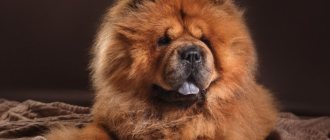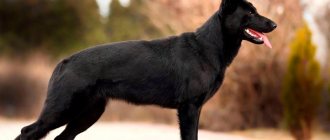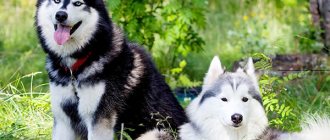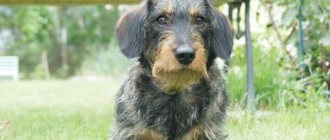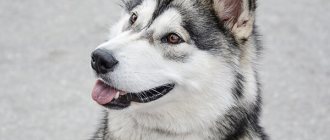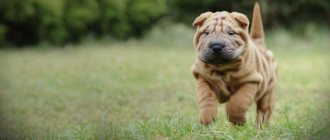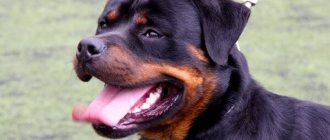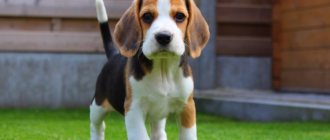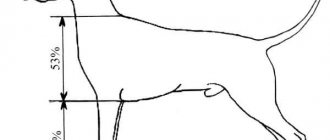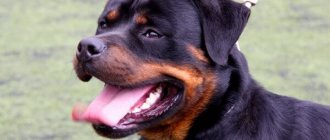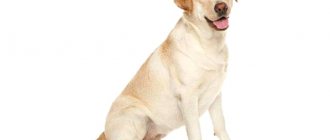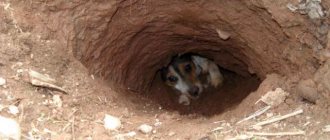A fox-like smiling face, a round head and snow-white thick fur - all this makes the Samoyed an incredibly attractive dog and a desirable pet. But what is hidden behind such a bright appearance?
The Samoyed Laika is a harmoniously built and elegant dog.
The cute appearance of a teddy white bear is deceptive: it is an active animal that vitally needs to expend its overflowing energy every day.
It is worth noting that the Samoyed’s beauty only “blooms” when in motion: the windier and colder the weather, the more fluffy and massive the dog visually becomes.
This phenomenon can be explained by swelling of the undercoat.
General characteristics of the breed
Samoyed dogs live well in outdoor conditions. This is an energetic and active dog that is easy to train. Samoyeds have a calm character and are affectionate and loyal to their owners.
The first representatives of the Arctic Spitz lived in cold latitudes. Modern dogs have adapted to temperate climates. They can be kept both indoors and outdoors - they do well in both cases.
Samoyeds are sociable and love to be the center of attention. They accompany their owner and love to play with him. The dogs are curious and mischievous, and have good patience - they can be taken into families with small children.
Interesting Facts
The snow-white fur coat and incredible fluffiness make their owners photogenic. Photos of Samoyed Laikas are on the covers of many magazines. Animals are often the stars of the silver screen.
Samoyed huskies live with popular personalities: Irina Dubtsova, Mikhail Kozyrev, Oleg Fomin and others.
It is interesting that snow-white parents can give birth to a baby with black fur. What this is connected with is still unknown.
Previously, the use of Samoyed huskies pursued a variety of purposes. They transported sleighs and cargo, and even hunted large prey with their owner. Samoyed dogs often acted as guards and nannies for small children during the absence of adult family members.
It is believed that items knitted from the wool of Samoyed huskies have healing properties. They have an anti-inflammatory effect and are able to cope with radiculitis, osteochondrosis, neuritis, rheumatism, nephritis, prostatitis, etc.
History of appearance
The Samoyed Laika dog is an ancient breed, its history goes back more than 3,000 years. It is one of the most ancient types of Spitz-type dogs. It exists in its original form: breeders did not work on it.
More than 3,000 years ago, snow-white fluffy dogs lived in the regions of Siberia, where they faithfully served their masters - the northern nomadic peoples. The tribes were called Samoyeds, and the breed got its name in honor of them.
Faithful dogs helped drive herds of deer and carried their owners in sleds. The nomads went bear hunting with their pets. To avoid freezing, people slept next to a fluffy dog - the thick fur provided good warmth in the harsh Siberian cold.
At a later time, the breed established itself well as a participant in polar expeditions. They do not abandon a person in trouble and help to survive in extreme conditions.
Appearance description
The breed comes in two varieties - bear and wolf. The first type is stocky: the body is short and powerful, the skull is wide. The second is distinguished by an elongated body and a narrow skull.
Wool
The breed has a thick coat with long hairs. This is due to the climate of the breed’s place of origin. In severe frost conditions, they needed to keep warm.
Dogs have two layers of fur with short undercoat. The outer layer is rough, with long hairs. A mane of long hair forms on the neck.
Torso
The Samoyed Laika is a medium-sized breed:
- The height of a male at the withers is 52-69 cm, and that of a female is 48-54 cm.
- The weight of a male is 21-30 kg, and that of a female is 16-21 kg.
Dogs have a long lifespan. With proper care, they live up to 12 - 15 years.
Limbs
The dogs' body is strong and muscular. The front legs are widely spaced and strong. When looking at the body from the front, the limbs appear straight and parallel. The hind legs are distinguished by well-developed muscles.
The gait of such dogs is energetic and tireless; they can move long distances without fatigue at an optimal pace. The hind limbs give powerful pushes, and the front limbs give a good reach.
Tail
Samoyeds have a high tail set. If the dog is excited or moving, the tail is curled behind the back or to the side. When at rest, it descends and reaches the hock joints.
Nurseries
It is necessary to purchase Samoyed Laika puppies from officially registered nurseries after studying their reviews. There are not many such nurseries in Russia: “Joy of Life”, “White Wolf”, “Arctic Avangard”, “Smile of the North”, “Snow Lace”. They guarantee the quality and health of the babies, as well as the availability of a veterinary passport with vaccination marks and other information. Keeping an animal will not be associated with unpredictable and sudden problems with health, temperament and mental state. A written purchase and sale agreement is required.
When purchasing second-hand or based on a photograph on the Internet, it is possible to receive out-of-breed or sick Samoyed Laikas at a high price.
Character
Samoyeds are friendly dogs with a gentle character. They treat all family members well and become loyal companions. Pets are trusting and love to communicate with people, so they are not suitable for protection. Such an animal will willingly make contact with a stranger.
Laikas are very sociable and love to spend time with their family. The pet will be in the center of events; it needs constant attention from its owners. This breed is not suitable for those who have little time to spend with their pet. If you don't give him enough time, he will start to get bored.
Representatives of the breed get along with children. Dogs are non-conflicting and can withstand excessive attention to themselves. They get along well with other pets.
Arctic Spitz need attention, bark a lot and try to entertain themselves. If you need a quiet and calm dog, then you should pay attention to other pets. Samoyeds need to be given constant physical activity and interact with them a lot. Puppies become calmer after two years; until this age they play a lot and are noisy.
Application
If earlier Samoyeds, like Weimaraners and Shorthaired Pointers , were used as hunters, now this function has long been lost due to the hunting instinct lost over time.
You can find out about other hunting dog breeds here:
But in the north, these dogs still remain excellent riding animals, capable of carrying slightly more weight than their own.
Due to their high social activity and goodwill, Samoyed huskies also cannot be used as guard dogs.
They remain wonderful companions for people and are also ideal for families with children. In addition, the Samoyed gets along well with other animals in the house.
In this case, there is no need to worry about the safety of all household members, since the dog will in no case show an aggressive attitude.
Friendliness is one of the main qualities of Samoyeds
How should training be carried out?
Training helps to raise an obedient pet. The owner should not physically punish the animal - this destroys its psyche. You need to raise a dog according to the principle of a pack, in which the leader is the owner.
The Samoyed should be given food after the whole family has eaten. The dog must have his own place - he should not be allowed to sleep in different places. After a walk, the owners enter the house first, and only then let the dog in.
Such simple principles allow the animal to learn who is in charge in the family. Once the puppy is three months old, you can start teaching him commands. Standard “Lie down!”, “Place!”, “Give me a paw!” are required skills. If you need to make a watchman out of an animal, then “Voice!” is additionally studied.
You can train a puppy either independently or in kennel clubs. Upon completion of the training, the owner will be awarded a certificate.
Features of care and maintenance
Samoyeds have long hair with a thick undercoat that needs to be combed regularly. During the molting period, owners carry out combing 2-3 times a week. It is not recommended to cut or shave the animal - its natural fur protects not only from cold, but also from heat or sunburn. For hygiene, the cover can be shortened slightly at the top of the paws or between the pads.
The animal sheds twice a year. For this period, you need to buy a slicker brush to make it easier to separate the undercoat. Dogs have very thick and long hair, so bathing them is difficult. Washing is carried out once every three to four months, this is enough. The breed is clean and has no smell.
Samoyed huskies need to be taken for walks every day. They are taken outside at least twice and spend a lot of time there playing and training. It is necessary to keep the dogs occupied with something: this way they will not be restless and noisy.
Main types of colors
White is the canonical color for the Samoyed.
Few people know, but the standard includes two more colors. Let's look at each in a little more detail :
- White . Looking at a white Samoyed, one would like to call it snow-white - its fur reflects sunlight and sparkles beautifully. This effect is created thanks to the translucent tips of the guard hairs.
- Cream . The wool has a pleasant, warm tint. A dog with this color looks attractive, but has much less chance at an exhibition than a snow-white individual.
- White with biscuit spots . The rarest color. The predominant mass of the fur is snow-white, and only some areas are chaotically colored in a pale, biscuit shade.
Yellowing of the Samoyed's white coat may be a sign of improper grooming , illness, or an excess of animal proteins in the dog's diet.
Sometimes black Samoyeds are also found, but this coat color is not recognized by the breed standard.
Pet health
Samoyed dogs are a strong and healthy breed; with proper nutrition and proper care, they rarely get sick. Veterinarians name the main diseases:
- digestive disorders;
- hip dysplasia;
- cataracts and glaucoma;
- depigmentation of the nose;
- retinal atrophy;
- aortic stenosis.
An unbalanced diet provokes the development of urolithiasis. Arthritis may appear in adulthood.
Samoyed photo
You can find numerous photos of Samoyed dogs on the Internet. From them you can judge the original appearance, as well as the cheerful, friendly disposition of the dog.
Tips for choosing a puppy
You should buy a puppy from responsible breeders. If they properly breed purebred dogs, then the animals turn out healthy and strong.
There are several basic rules for choosing:
- You can buy a puppy at the age of 45 days. It must be neat and clean.
- There should be no unpleasant odors in the breeders' apartment. This is a sign not only of their cleanliness, but also of a good attitude towards their pets.
- The baby's eyes should be clean and free of pus. There should be no excess wax in the ears.
- The baby's bite should be correct, without any curvature. A puppy that meets the standards will have black pigmentation on his lips. The presence of several dots indicates that the color will be uniform with age.
- If there is a hernia on the abdomen, it will be removed at the seller's expense.
- The paws should be parallel to each other and level, with the elbows pressed against the ribs when the dog moves.
- By 8 weeks, Samoyed puppies already have their tail positioned correctly. It should fit against the back of the hook and not hang to the side.
Experienced breeders have their pets wormed. The first time deworming is carried out at the age of 21 days, then every 10 days until the age of two months.
What is the price?
As for pricing, the final cost is determined depending on several components: the purity of the breed, club and class.
Eg:
- Puppies without a brand do not participate in breeding. Average price from 8 to 15 thousand rubles
- Breed class (most often used in breeding). The average price is from 25 to 35 thousand rubles.
- Show class - the dog meets 100% standard characteristics. This option is suitable for those who want their dog to participate in exhibitions and receive titles. The most expensive option of all is from 35 to 65 thousand rubles.
